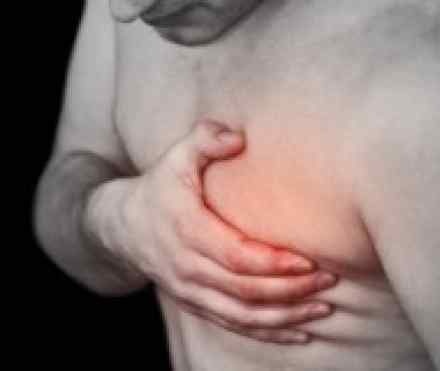
What is it?
- Gynaecomastia is swelling of the breast tissue in boys or men, caused by an imbalance of the hormones oestrogen and testosterone. Newborns, boys going through puberty and older men often develop gynaecomastia as a result of normal changes in hormone levels. There are other causes as well.
- Generally, gynaecomastia isn't a serious problem, but it can be tough to cope with. Men and boys with gynaecomastia sometimes have pain in their breasts and may feel embarrassed.
- Gynaecomastia may go away on its own. Gynaecomastia can also be treated with medications that help balance hormone levels. In some cases, surgery to remove breast tissue also may be an option.
Symptoms
Signs and symptoms of gynaecomastia include:
- Swollen breast gland tissue
- Breast tenderness
Causes
Gynaecomastia is triggered by a decrease in the amount of the hormone testosterone compared with oestrogen. The cause of this decrease can be conditions that block the effects of or reduce testosterone or by a condition that increases your estrogen level. Several things can upset the hormone balance, including:
- Natural hormone changes
- Medications
- Certain health conditions
In about 25 percent of cases, the cause of gynecomastia is never found.
The testosterone-estrogen balance
The hormones testosterone and estrogen control the development and maintenance of sex characteristics in both men and women. Testosterone controls male traits such as muscle mass and body hair; oestrogen controls female traits including the growth of breasts.
Most people think of estrogen as an exclusively female hormone, but men also produce it — though normally in small quantities. Oestrogen helps regulate bone density, sperm production and mood. But male estrogen levels that are too high or are out of balance with testosterone levels can cause gynaecomastia.
Gynaecomastia in infants
More than half of male infants are born with enlarged breasts due to the effects of their mother's oestrogen. Generally the swollen breast tissue goes away within two to three weeks after birth.
Gynaecomastia during puberty
Gynaecomastia caused by hormone changes during puberty is common. In most cases, the swollen breast tissue will go away without treatment within six months to two or three years.
Gynaecomastia in men
The prevalence of gynaecomastia peaks again between the ages of 50 and 80. At least one-quarter of men are affected during this time.
Medications
A number of medications can cause gynaecomastia. These include certain:
- Anti-androgens used to treat prostate enlargement or cancer and some other conditions. Examples include cyproterone, flutamide, finasteride and spironolactone.
- AIDS medications. Gynaecomastia can develop in HIV-positive men who are receiving a treatment regimen called highly active antiretroviral therapy (HAART). Efavirenz is more commonly associated with gynecomastia than are other HIV medications.
- Anti-anxiety medications, such as diazepam (Valium).
- Tricyclic antidepressants.
- Antibiotics.
- Ulcer medications, such as cimetidine.
- Cancer treatment (chemotherapy).
- Heart medications, such as digitalis and calcium channel blockers.
Street drugs and alcohol
Substances that can cause gynaecomastia include:
- Anabolic steroids and androgens
- Alcohol
- Amphetamines
- Marijuana
- Heroin
Health conditions
Several health conditions can cause gynecomastia by affecting the normal balance of hormones. These include:
Hypogonadism. Any of the conditions that interfere with normal testosterone production, such as Klinefelter syndrome or pituitary insufficiency, can be associated with gynaecomastia.
- Aging. Hormone changes that occur with normal aging can cause gynaecomastia, especially in men who are overweight.
- Tumors. Some tumors, such as those involving the testes, adrenal glands or pituitary gland, can produce hormones that alter the male-female hormone balance.
- Hyperthyroidism. In this condition, the thyroid gland produces too much of the hormone thyroxine.
- Kidney failure.
- Liver failure and cirrhosis.
- Malnutrition and starvation.
Herbal products
Plant oils, such as tea tree or lavender, used in shampoos, soaps or lotions, have been associated with gynaecomastia. This is probably due to their weak estrogenic activity.
Risk factors
Risk factors for gynaecomastia include:
- Adolescence
- Older age
- Use of anabolic steroids or androgens to enhance athletic performance
- Certain health conditions, including liver and kidney disease, thyroid disease, hormonally active tumors, and Klinefelter syndrome
Complications
Although there are few physical complications associated with gynecomastia, having this condition can cause psychological or emotional trouble caused by appearance.
Diagnosis
Your doctor will ask you questions about your medical history, what medications you're taking and what health conditions run in your family. The doctor will also do a physical examination that may include careful evaluation of your breast tissue, abdomen and genitals.
Your doctor will want to be sure your breast swelling is actually gynecomastia and not another condition. Other conditions that can cause similar symptoms include:
- Fatty breast tissue. Some men and boys have chest fat that resembles gynecomastia. This is called pseudogynecomastia or false gynaecomastia, and it isn't the same as gynaecomastia.
- Breast cancer. This is uncommon in men, but can occur. Enlargement of one breast or the presence of a firm nodule raises the concern for male breast cancer.
- A breast abscess (mastitis).
Initial tests to determine the cause of your gynaecomastia may include:
- Blood tests
- Mammograms
You may need further testing depending on your initial test results, including:
- Chest X-rays
- Computerized tomography (CT) scans
- Magnetic resonance imaging (MRI) scans
- Testicular ultrasounds
- Tissue biopsies
References:
https://www.nlm.nih.gov/medlineplus/ency/article/003165.htm
https://en.wikipedia.org/wiki/Gynecomastia
http://www.medicinenet.com/gynecomastia/article.htm
http://emedicine.medscape.com/article/120858-overview
http://www.aestheticsurgery.ie/men-surgical/body-men/body-gynecomastia-men

